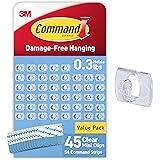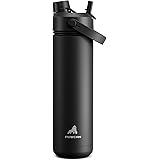Planning a trip and want to bring the beauty of fresh flowers with you? Whether it’s a gift for a loved one, a souvenir from a special event, or just a way to brighten up your destination, transporting flowers on a plane requires some careful planning.
In 2025, understanding the latest regulations from the Transportation Security Administration (TSA) and potential international rules is crucial for a smooth travel experience. This comprehensive guide will cover everything you need to know about flying with flowers, from packing techniques to navigating customs, ensuring your precious blooms arrive fresh and vibrant.
Table of Contents
Understanding the TSA Regulations for Flowers
The first step in your floral travel journey is understanding the rules set by the TSA. Luckily, bringing flowers on a plane within the United States is generally permitted, but there are a few key considerations.
TSA’s General Stance on Flowers
The TSA generally allows passengers to bring fresh flowers, live plants, and floral arrangements in both carry-on and checked baggage. The primary concern for TSA agents is always security, so your flowers will be subject to inspection. This means that agents might need to open containers or examine the arrangement to ensure there are no prohibited items hidden inside.

Key Considerations for TSA Inspection
To minimize delays and potential issues during screening, keep these points in mind:
- Visibility: Make sure the flowers are easily visible. Avoid wrapping them in excessive layers of paper or opaque materials that might raise suspicion.
- Soil: If your arrangement includes soil, be aware that excessive amounts of soil might be subject to closer inspection. While small amounts are usually fine, large quantities could potentially be flagged.
- Water: If the flowers are in water, you’ll need to comply with the TSA’s liquid rules. For carry-on baggage, this means the container must adhere to the 3-1-1 rule (3.4-ounce or 100-milliliter containers in a single, quart-sized, clear plastic zip-top bag). Consider draining the water before going through security and refilling it after you pass through, or using water-absorbing floral foam.
- Sharp Objects: Any sharp tools used for arranging the flowers, such as knives or scissors, must be packed in your checked baggage.
Real-World Example: Navigating TSA with a Bouquet
Imagine you’re traveling from Seattle to Denver with a beautiful bouquet of roses for your mother’s birthday. To ensure a smooth TSA experience, you’ve wrapped the stems in a damp paper towel and secured it with tape. The bouquet is loosely wrapped in clear cellophane. When you go through security, be prepared to take the bouquet out of your bag (if it’s in one) and place it in a bin for screening. TSA agents might visually inspect the flowers and the wrapping. As long as everything is visible and there are no prohibited items hidden within, you should have no problems.
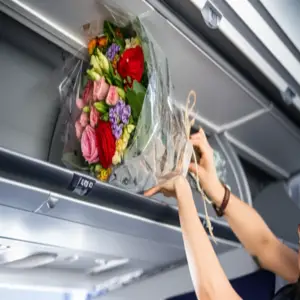
flying with flowers
Packing Flowers for Air Travel: A Step-by-Step Guide
Proper packing is crucial for ensuring your flowers arrive at your destination looking their best. Here’s a detailed guide to help you pack flowers for air travel:
Step 1: Hydration is Key
Keeping your flowers hydrated is essential for their survival during travel. Here are a few hydration methods:
- Water Tubes: These small plastic tubes filled with water are designed to keep individual stems hydrated. They’re ideal for longer journeys.
- Damp Paper Towels: Wrap the cut ends of the stems in damp paper towels and secure them with tape or a rubber band. This is a simpler option for shorter trips.
- Floral Foam: Soak floral foam in water and insert the stems into the foam. This provides both hydration and support.
- Gel Packs: Hydrated gel packs, similar to those used for shipping perishable foods, can keep the stems cool and moist. Make sure they are properly sealed to prevent leaks.
Read More: Can You Bring Melatonin on a Plane? 2024 Travel Guide
Step 2: Protecting the Blooms
The delicate blooms need protection from physical damage during transit. Consider these options:
- Clear Cellophane: Loosely wrap the flowers in clear cellophane or plastic wrap. This provides a barrier against drafts and helps maintain humidity.
- Bubble Wrap: For more fragile flowers, use bubble wrap to cushion the blooms. Be careful not to crush the flowers.
- Flower Boxes: Specially designed flower boxes provide a rigid structure to protect the flowers. These are available at most florists and online retailers.
- DIY Cardboard Support: You can create your own support structure using cardboard. Cut a piece of cardboard slightly larger than the flower head and create a cone or dome shape around the blooms. Secure it with tape.
Step 3: Choosing the Right Container
The container you choose depends on whether you’re carrying the flowers on the plane or checking them in your luggage.
- Carry-on: If you’re carrying the flowers on, you’ll want a container that’s easy to handle and won’t take up too much space. A sturdy tote bag or a small flower box works well.
- Checked Baggage: For checked baggage, you’ll need a more robust container to withstand the rigors of baggage handling. A hard-sided suitcase with adequate padding is recommended.
Step 4: Securing the Flowers in the Container
Prevent the flowers from shifting around during transport by securing them inside the container.
- Packing Material: Use packing peanuts, crumpled paper, or bubble wrap to fill any empty spaces in the container and prevent the flowers from moving.
- Tape or Straps: Use tape or straps to secure the flower box or container to the inside of your suitcase, especially if you are checking it.
Step 5: Labeling the Package
Clearly label the package as “Fragile” and “Perishable.” This will alert baggage handlers to handle the package with care.
Table: Packing Materials and Their Uses
| Packing Material | Use | Benefits | Drawbacks |
|---|---|---|---|
| Water Tubes | Hydrating individual stems | Provides targeted hydration, easy to use | Only suitable for individual stems |
| Damp Paper Towels | Hydrating stems | Simple, readily available | Dries out quickly, less effective for long trips |
| Floral Foam | Hydrating and supporting stems | Provides both hydration and support | Can be messy, needs to be kept moist |
| Clear Cellophane | Protecting blooms from drafts | Lightweight, allows for visibility | Offers minimal physical protection |
| Bubble Wrap | Cushioning fragile blooms | Provides good physical protection | Can crush delicate flowers if not used carefully |
| Flower Boxes | Protecting entire arrangements | Rigid structure, provides excellent protection | Can be bulky and expensive |
| Packing Peanuts/Crumpled Paper | Filling empty spaces | Prevents movement, cushions the arrangement | Can be messy, may not provide adequate protection for very delicate flowers |
Example: Packing a Delicate Orchid
Let’s say you’re bringing a delicate orchid on a flight from Miami to New York. First, you’d carefully wrap the orchid’s pot in bubble wrap to protect it. Then, you’d place the entire plant inside a sturdy flower box. You’d use packing peanuts to fill any empty spaces in the box to prevent the plant from shifting. Finally, you’d label the box as “Fragile” and “Perishable” and carry it on the plane. Once on board, you would carefully place the box in the overhead compartment or under the seat in front of you.
Navigating International Travel with Flowers
Bringing flowers on an international flight introduces a new layer of complexity. Different countries have varying regulations regarding the import of plants and plant products. These regulations are primarily in place to prevent the introduction of pests and diseases that could harm local agriculture and ecosystems.
Understanding Import Regulations
Before traveling internationally with flowers, it’s crucial to research the import regulations of your destination country. You can usually find this information on the website of the country’s agricultural or customs department. Search for terms like “plant import regulations,” “phytosanitary certificates,” or “customs restrictions for plants.”
Here are some key aspects to consider:
- Prohibited Species: Some countries prohibit the import of certain plant species altogether. Make sure the flowers you’re carrying are not on the prohibited list.
- Phytosanitary Certificates: Many countries require a phytosanitary certificate for imported plants. This certificate, issued by the exporting country’s agricultural authority, confirms that the plants have been inspected and are free from pests and diseases.
- Inspection at Customs: Be prepared for your flowers to be inspected by customs officials upon arrival in your destination country. They may examine the flowers for signs of pests or diseases and verify that you have the necessary documentation.
- Declaration: Always declare that you are carrying flowers on your customs form. Failure to do so could result in fines or confiscation of the flowers.
Examples of International Flower Import Regulations
Here are a few examples of how flower import regulations can vary:
- Australia: Australia has very strict biosecurity regulations. Most fresh flowers are prohibited from being imported without a permit and a phytosanitary certificate. Even with these documents, the flowers may be subject to quarantine upon arrival.
- European Union: The EU has a common plant health regime. Importing certain plants and plant products from outside the EU may require a phytosanitary certificate. Check the specific requirements for your destination country.
- Canada: Canada’s import regulations vary depending on the type of plant and its origin. Some plants may require a phytosanitary certificate, while others may be allowed with a simple inspection.
- Japan: Japan has strict rules on importing plants to protect its agriculture. Many items are prohibited. Those that are allowed require a phytosanitary certificate from the country of origin.
Obtaining a Phytosanitary Certificate
If your destination country requires a phytosanitary certificate, you’ll need to obtain one from your local agricultural authority before you travel. The process typically involves:
- Contacting the Agricultural Authority: Contact your local agricultural authority (e.g., the USDA in the United States) to inquire about the requirements for obtaining a phytosanitary certificate for flowers.
- Inspection: An inspector will examine the flowers to ensure they are free from pests and diseases.
- Documentation: You’ll need to provide documentation about the origin of the flowers, such as receipts or invoices.
- Certificate Issuance: If the flowers pass inspection, the agricultural authority will issue a phytosanitary certificate.
Table: Examples of International Flower Import Regulations (2024)
| Country | Import Regulations | Phytosanitary Certificate Required? | Additional Notes |
|---|---|---|---|
| Australia | Very strict biosecurity regulations. Many fresh flowers are prohibited without a permit. | Yes, typically required. | Even with a certificate, quarantine may be required upon arrival. Check the Australian Department of Agriculture and Water Resources website for specific restrictions. |
| European Union | Regulations vary by country and plant type. | Potentially, depending on the plant and country of origin. | Consult the plant health regulations for the specific EU country you are visiting. The EU Commission website provides details. |
| Canada | Regulations vary by plant and origin. | Potentially, depending on the plant and origin. | Check the Canadian Food Inspection Agency (CFIA) website for specific requirements. |
| Japan | Strict regulations to protect agriculture. | Yes, often required. | Check the Ministry of Agriculture, Forestry and Fisheries (MAFF) website for detailed restrictions. |
| United Kingdom | Regulations are similar to the EU’s but are subject to change post-Brexit. | Potentially, depending on the plant and origin. | Consult the UK’s Department for Environment, Food & Rural Affairs (Defra) website for the most up-to-date information. |
Real-World Example: Traveling to the UK with Flowers
Imagine you’re traveling from the United States to the UK with a bouquet of Californian poppies. Before your trip, you should visit the UK’s Department for Environment, Food & Rural Affairs (Defra) website to check their import regulations. You discover that while poppies aren’t specifically prohibited, all plant imports from the US require a phytosanitary certificate. You then contact the USDA in your state to arrange for an inspection and obtain the necessary certificate. Upon arrival in the UK, you declare the flowers on your customs form and present the phytosanitary certificate to the customs official. They inspect the flowers to ensure they match the certificate and are free from pests. If everything is in order, you’ll be allowed to bring the flowers into the UK.
Keeping Flowers Fresh During the Flight
Even with careful packing, the conditions inside an airplane cabin can be harsh on flowers. The low humidity and fluctuating temperatures can cause them to wilt and dry out quickly. Here are some tips for keeping your flowers fresh during the flight:
Minimize Exposure to Extreme Temperatures
Avoid placing your flowers in direct sunlight or near heating vents. The overhead compartments are generally cooler than the area under the seats, so consider storing them there if space is available.
Maintain Humidity
Continue to hydrate the flowers throughout the flight. If you’re using water tubes, check them periodically and refill them as needed. If you’re using damp paper towels, re-moisten them occasionally.
Avoid Crushing
Be careful not to crush the flowers when placing them in the overhead compartment or under the seat. Make sure they are not being squeezed or compressed by other luggage.
Consider Anti-Transpirant Sprays
Anti-transpirant sprays, available at most florists, can help reduce water loss from the flowers’ leaves and petals. These sprays create a protective coating that slows down the transpiration process.
Post-Flight Care
Once you arrive at your destination, give your flowers some extra care to help them recover from the journey.
- Re-cut the Stems: Re-cut the stems at a 45-degree angle to improve water absorption.
- Remove Damaged Leaves: Remove any damaged or wilted leaves from below the waterline.
- Place in Fresh Water: Place the flowers in a clean vase filled with fresh, cool water. Add flower food to the water to provide nutrients and prevent bacterial growth.
- Avoid Direct Sunlight: Keep the flowers away from direct sunlight and drafts.
Table: Troubleshooting Flower Freshness Issues
| Issue | Possible Cause | Solution |
|---|---|---|
| Wilting | Dehydration, temperature fluctuations | Re-cut stems, rehydrate, move to a cooler location, use anti-transpirant spray |
| Brown Spots on Petals | Bruising, physical damage | Handle with care, provide cushioning during transport |
| Yellowing Leaves | Stress, lack of nutrients | Remove yellow leaves, add flower food to the water |
| Foul Odor | Bacterial growth | Change water frequently, add flower food, clean the vase |
| Drooping heads | Air embolism (air bubble blocking water uptake) | Recut stem underwater to prevent air from re-entering the stem. Submerge the entire flower in cool water for 30 minutes to hydrate the petals. |
Real-World Example: Reviving Flowers After a Long Flight
Imagine you’ve just arrived in Paris after a 10-hour flight from New York with a bouquet of lilies. When you open the flower box, you notice that the lilies are looking a bit droopy. The first thing you do is re-cut the stems at a 45-degree angle and remove any damaged leaves. Then, you fill a clean vase with fresh, cool water and add a packet of flower food. You place the lilies in the vase and leave them in a cool, dark room for a few hours. By the next morning, the lilies have perked up and are looking much healthier.
Alternatives to Bringing Fresh Flowers
If you’re concerned about the hassle or risk of traveling with fresh flowers, there are several alternatives to consider:
Ordering Flowers Online for Delivery
The easiest option is to order flowers online from a local florist at your destination. Many online flower delivery services offer a wide selection of arrangements and can deliver them directly to your hotel or other location.
Dried Flowers or Preserved Flowers
Dried flowers and preserved flowers are a beautiful and long-lasting alternative to fresh flowers. They don’t require water and are much less susceptible to damage during travel. They also don’t fall under the same agricultural restrictions as live plants.
Artificial Flowers
High-quality artificial flowers can look surprisingly realistic and are a great option for adding a touch of beauty to your destination without the worry of wilting or damage. They are also very lightweight and easy to pack.
Photographs or Paintings of Flowers
If you simply want to bring the beauty of flowers with you in a symbolic way, consider bringing photographs or paintings of flowers. These are easy to pack and won’t be subject to any travel restrictions.
Gifting a Flower Subscription
Instead of transporting flowers, consider gifting a flower subscription to someone at your destination. This allows them to receive fresh flowers regularly from a local florist, without you having to worry about travel restrictions.
Table: Alternatives to Bringing Fresh Flowers
| Alternative | Benefits | Drawbacks |
|---|---|---|
| Online Flower Delivery | Convenient, wide selection, supports local businesses | May be more expensive, relies on the quality of the local florist |
| Dried/Preserved Flowers | Long-lasting, no watering required, fewer travel restrictions | May not have the same vibrancy as fresh flowers, can be fragile |
| Artificial Flowers | Durable, lightweight, easy to pack | May not look as realistic as fresh flowers, can be perceived as less sentimental |
| Photographs/Paintings | Easy to pack, no risk of damage, no travel restrictions | Not the same as having real flowers, purely symbolic |
| Flower Subscription | Ongoing gift, supports local florists | Recipient must be in a serviceable area, requires recipient management |
Real-World Example: Choosing Dried Flowers for a Destination Wedding
Imagine you’re attending a destination wedding in Italy. Instead of trying to transport a fresh floral centerpiece, you decide to bring a beautiful arrangement of dried lavender and wildflowers. The dried flowers are lightweight, easy to pack, and won’t wilt during the long flight. Plus, they can be kept as a lasting reminder of the special occasion.
Legal and Ethical Considerations
Beyond the TSA regulations and import restrictions, there are also some legal and ethical considerations to keep in mind when traveling with flowers.
Protecting Endangered Species
Be aware that some flowers are protected by international agreements, such as the Convention on International Trade in Endangered Species (CITES). It is illegal to transport endangered species or products made from them without the proper permits.
Avoiding Invasive Species
Be careful not to transport flowers that could be invasive in your destination country. Invasive species can harm local ecosystems and agriculture. Research the potential impact of the flowers you’re carrying and avoid bringing any that could pose a threat.
Supporting Sustainable Floriculture
Consider supporting sustainable floriculture practices by choosing flowers that are grown locally and ethically. Look for florists who source their flowers from farms that use environmentally friendly methods and treat their workers fairly.
Respecting Local Regulations
Be aware of any local regulations regarding the collection of wildflowers or other plants. In some areas, it may be illegal to pick flowers from public lands or private property.
Example: Avoiding Illegal Flower Transport
You are thinking of bringing a rare orchid, found only in a specific region, back home after a trip. However, you realize this orchid is protected under CITES. Attempting to bring it home would be illegal and could result in severe penalties. Instead, you purchase a photograph of the orchid to remind you of your trip, ensuring you’re acting legally and ethically.
Current Trends in Flower Travel
Flower travel is becoming increasingly popular, driven by several trends:
Destination Weddings and Events
More and more people are choosing to have destination weddings and events, and they want to bring special floral arrangements with them to personalize the occasion.
Floral Tourism
Floral tourism, where people travel specifically to see or experience flowers in bloom, is a growing trend. Travelers often want to bring a piece of that experience home with them.
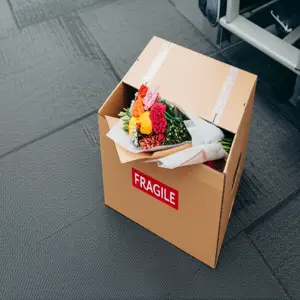
transporting floral arrangements
Social Media Influence
Social media platforms like Instagram and Pinterest have fueled the desire to share beautiful floral arrangements, leading people to seek out unique flowers and transport them to create stunning photos.
Growing Appreciation for Flowers
There is a growing appreciation for the beauty and symbolism of flowers, leading people to incorporate them into their travel experiences.
Trend: DIY Flower Preservation
Many travelers are interested in preserving flowers they acquired during their trip. DIY flower preservation methods, such as pressing or drying, have gained popularity due to easy access to information and tools. This allows individuals to create lasting mementos.
Data & Statistics: The Growing Flower Market
According to recent market research, the global cut flower market is projected to reach $41.8 billion by 2027, growing at a CAGR of 6.4% from 2020. This growth indicates an increasing interest in flowers and the associated activities, including flower travel.
Read More: Can You Bring Aerosol on a Plane? 2025 Airline Rules!
Flower Care Kits for Travelers
To make traveling with flowers easier, several companies now offer flower care kits specifically designed for travelers. These kits typically include:
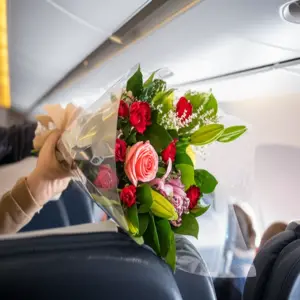
airline flower policy
- Water tubes or gel packs
- Flower food
- Anti-transpirant spray
- Protective wrapping material
- Instructions for packing and caring for flowers
Benefits of Flower Care Kits
- Convenience: Provide everything needed for proper care in a single package.
- Protection: Help maintain the flowers’ hydration and prevent damage during transport.
- Education: Offer guidance on optimal packing and care practices.
Common Mistakes to Avoid When Flying with Flowers
To ensure a smooth and successful flower travel experience, avoid these common mistakes:
- Not Researching Regulations: Failing to check the TSA regulations and import restrictions of your destination country.
- Poor Packing: Not packing the flowers properly to protect them from damage and dehydration.
- Overwatering: Using too much water, which can lead to leaks and TSA scrutiny.
- Hiding Flowers: Concealing flowers in a way that raises suspicion.
- Ignoring Local Laws: Violating local regulations regarding the collection of wildflowers.
- Assuming all flowers are acceptable: Incorrectly assuming every flower is safe to transport without checking import regulations.
FAQ: Frequently Asked Questions About Bringing Flowers on a Plane
1. Can I bring flowers on a plane in my carry-on?
Yes, the TSA generally allows passengers to bring fresh flowers in carry-on baggage. However, be prepared for the flowers to be inspected by TSA agents. If the flowers are in water, the container must comply with the TSA’s liquid rules (3.4-ounce or 100-milliliter containers in a single, quart-sized, clear plastic zip-top bag). It’s generally recommended to drain the water before going through security.
2. Can I bring flowers on a plane in my checked baggage?
Yes, you can also bring flowers in your checked baggage. However, it’s crucial to pack the flowers carefully to protect them from damage during baggage handling. Use a sturdy container and adequate padding to prevent crushing.
3. What if my flowers are confiscated at customs?
If your flowers are confiscated at customs, it’s usually because they violate the import regulations of the destination country. You may be able to appeal the decision, but it’s unlikely that you’ll be able to get the flowers back. To avoid this, always research the import regulations before you travel.
4. Do I need a phytosanitary certificate to bring flowers on a domestic flight?
No, a phytosanitary certificate is generally not required for domestic flights within the United States. However, it may be required for international flights, depending on the import regulations of the destination country.
5. How can I keep my flowers hydrated during a long flight?
Use water tubes, damp paper towels, or floral foam to keep the stems hydrated. Re-moisten the paper towels or refill the water tubes as needed during the flight. Consider using anti-transpirant spray to reduce water loss from the leaves and petals.
6. Can I bring plants with soil on a plane?
Yes, you can generally bring plants with soil on a plane, but the TSA might inspect them more closely. If traveling internationally, be aware that many countries have strict regulations regarding the import of soil due to the risk of pests and diseases. Always check the import regulations of your destination country.
7. Are there any flowers that are prohibited from being brought on a plane?
There aren’t specific types of flowers prohibited by the TSA for domestic flights. However, internationally, certain flowers might be prohibited based on the destination’s import regulations, especially if they are considered invasive species or protected under CITES.
8. What’s the best way to pack a large bouquet for air travel?
For a large bouquet, use a sturdy flower box with adequate padding. Secure the stems with water tubes or damp paper towels. Fill any empty spaces in the box with packing peanuts or crumpled paper to prevent the flowers from shifting. Label the box as “Fragile” and “Perishable.”
9. Where can I find more information about international flower import regulations?
You can find information about international flower import regulations on the website of the destination country’s agricultural or customs department. Search for terms like “plant import regulations,” “phytosanitary certificates,” or “customs restrictions for plants.” You can also contact the embassy or consulate of the destination country for assistance.
10. What should I do if my flowers start to wilt during the flight?
If your flowers start to wilt, try re-moistening the stems with water. If possible, move them to a cooler location, such as the overhead compartment. Once you arrive at your destination, re-cut the stems and place the flowers in fresh water with flower food.
11. Can I take seeds or bulbs on a plane?
Yes, you can usually take seeds and bulbs on a plane in both carry-on and checked baggage. However, international travel may be subject to strict regulations depending on the destination country. Always check import requirements before you fly.
12. What should I do if I am unsure about whether a certain type of flower is allowed?
When in doubt, it is best to contact the agricultural department or customs office of your destination country. They can provide definitive information regarding the specific types of flowers or plants that are allowed. For domestic flights, you can contact the TSA directly with any questions.
Conclusion: Final Thoughts on Traveling with Flowers
Bringing flowers on a plane can add a touch of beauty and sentimentality to your travel experience. However, it requires careful planning and adherence to regulations. By understanding the TSA rules, packing your flowers properly, researching international import restrictions, and taking steps to keep your flowers fresh, you can increase your chances of a successful floral journey. If the hassle seems too much, remember that there are many excellent alternatives, such as ordering flowers online or bringing dried or artificial arrangements. Ultimately, the decision of whether to bring flowers on a plane depends on your individual circumstances, your willingness to do the necessary research and preparation, and the value you place on having those fresh blooms with you at your destination.
In 2024, with the increasing globalization and ease of travel, understanding these nuances becomes ever more crucial. The joy of gifting a fresh bouquet, experiencing floral tourism, or personalizing a destination event with beloved blooms is undeniable. But remember, acting responsibly by respecting legal and ethical considerations ensures that everyone can enjoy the beauty of flowers without causing harm to the environment or breaking the law. Whether you’re a seasoned traveler or embarking on your first floral adventure, keep this guide handy, adapt your plans as needed, and embrace the fragrant journey!
Happy travels, and may your journey be filled with beautiful blooms!



